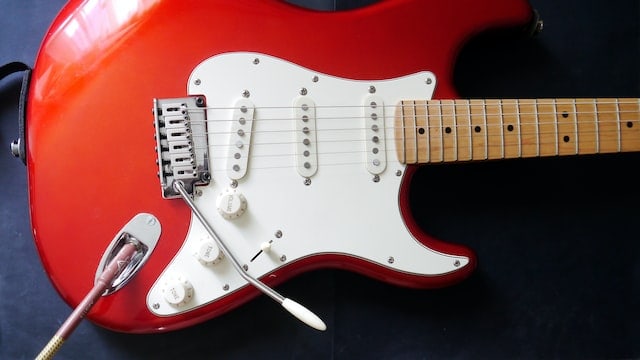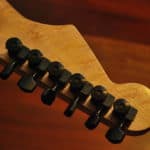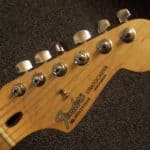The guitar is such a versatile instrument that, we could say, provides almost infinite possibilities.
We are not referring merely to the chord progressions and solos that one can create with it. We are talking about sound.
There are hundreds of effect pedals, amp settings, and other tools that help you create unique results.
One of these tools is the whammy bar.
The whammy bar (also known as tremolo bar) is a metal bar that allows you to bend the strings and generate an interesting effect.
However, the whammy bar is also a bit unpopular among guitarists. After all, using it too much leads to unpleasant results.
But are these results permanent? Will the whammy bar actually destroy your beloved guitar?
The whammy bar cannot damage a guitar. However, it’s possible that it detunes the strings or even breaks them. Other than that, you can play safely, knowing that your guitar won’t suffer major inconveniences.
Now, if you are here, then it’s because you either have a whammy bar or are planning to get one.
In that case, you’ll want to know how to solve any inconvenience you may face in the future.
Easy, we have it all covered in this article.
Is using the whammy bar bad for your guitar?
Luckily, using a whammy bar won’t damage your guitar at all.
All things considered, there are certain “problems” that could emerge after using your whammy bar.
However, there’s a huge difference between causing a problem and damaging the guitar.
That is to say, if something is bad for your guitar, then it can cause long-term issues that would require some long-term solutions, such as having someone repair the instrument for you (or completely getting rid of it, in the worst of cases).
On the other hand, a “problem” is short-termed and can be solved with little to no effort.
We’ll discuss these issues below.
So, long story short, it’s impossible to permanently break or damage your guitar by using the whammy bar.
3 problems that a whammy bar can cause to your guitar
So, abusing the might of your whammy bar won’t damage your guitar. That’s really cool!
You can go play the “80’s Metal Guitar Hero” all you want!
Oh sure, but before that, bear in mind that there are 3 issues you’ll most likely face.
1. Strings Go Out of Tune
Guitar strings can go out of tune when using the Whammy bar too much. After all, the tool literally bends the strings.
Naturally, you can expect the strings to detune when they get stuck at the nut. Of course, this is not too much of a problem, to be honest.
The thing is that you’ll need to tune every now and then, which is time-consuming, and a bit annoying.
2. Strings Break
This is even worse! Now you not only need to tune a string, but you also have to buy a brand new one.
This, however (and luckily), is not always the case.
You’ll break a string if the string is dragging on the saddle or nut. Also, if you tune higher (over E standard), then chances increase.
Nonetheless, you don’t need to use a tremolo bar to break a string when tuning higher. Higher tunings leave the strings too tight, which naturally, increases the chances of being broken.
3. Damages the Bridge (Really?)
This is the least likely case scenario. In reality, is not a problem regarding the whammy bar, but how bad it has been installed.
To be more precise, a poorly installed whammy bar could damage the bridge when pressing too hard on it. But remember, this has nothing to do with the tremolo bar itself.
How to avoid issues caused by the whammy bar on your guitar
There are a lot of tips to follow and avoid your whammy bar causing nuisances.
Here’s what you need to do:
- Use a locking nut: whenever you bend your strings with a tremolo bar, the locking nut will keep the strings in their corresponding place. We recommend you install a locking nut by a professional, and not by yourself since it’s no easy task.
- Use locking tuners: these are similar to locking nuts. The locking tuners are tuning posts that come with a bracket that locks the string in its place. This tool is easier to install than a locking nut.
- Install more springs: go to the back of your guitar, and find the tremolo system. There, you’ll find two or three springs, depending on the guitar. Add some more, and the whammy bar will be harder to move (but will avoid detuning the strings).
- Non-floating system: non-floating tremolos are better to keep your strings in tune for longer.
- Lubricant: apply some tuning lubricant to the contact points of the string. That is to say, in the nut, and the bridge.
- Watch out for new strings: the newer the strings, the bigger the chances of them detuning. Stretch the strings and give them some time. Once they “get used” to the guitar, it’ll be simpler to use your whammy bar without detuning the strings.
- Avoid using the whammy bar too much: seriously. Like, if you’re on a Steve Vai tribute band, then that’s okay. Otherwise, just, calm down. Please. Just a bit.
Should you refrain from using your whammy bar extensively?
Okay, so, I apologize.
I know I said that reducing the time you use the whammy bar is actually a good form of preventing tuning stability issues.
Although this is a fact, we encourage you not to deprive yourself of the joy of “whammying” all you want.
After all, the music you want to play may require you to use the tremolo a lot. That’s fantastic, and if you believe it’s a pivotal aspect of your personal style, then use it as much as you can.
Not using the tremolo bar is just general advice for beginners, who might be unaware of how much it affects tuning stability.
So, it’s good to be attentive to such detail, to avoid detuning your instrument in the middle of a performance.
Other than that, you can use the whammy bar as much as you can.
Simply apply the tips we provided in the section above, or, in the worst case, just accept the consequences.
Do all whammy bars cause problems?
Every tremolo bar causes detuning issues.
This is the case even for non-floating tremolo guitars.
The only way to avoid all the problems mentioned before is to implement as many tips as you can: lubricating the nut and bridge, installing more springs, working with a non-floating tremolo, and using a locking nut.
However, even that is not a guarantee that the tremolo will work flawlessly.
The best you can do is prepare yourself as much as you can, but be ready to tune every now and then anyway.
What do you think? Is the whammy bar really worth it?
As usual, you have the final words.

Hello there, my name is Ramiro and I’ve been playing guitar for almost 20 years. I’m obsessed with everything gear-related and I thought it might be worth sharing it. From guitars, pedals, amps, and synths to studio gear and production tips, I hope you find what I post here useful, and I’ll try my best to keep it entertaining also.





